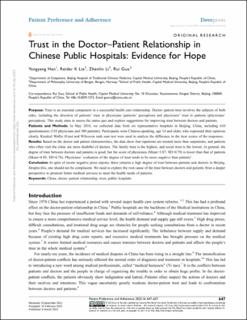| dc.contributor.author | Han, Yangyang | |
| dc.contributor.author | Lie, Reidar Krummradt | |
| dc.contributor.author | Li, Zhenlin | |
| dc.contributor.author | Guo, Rui | |
| dc.date.accessioned | 2023-01-05T13:50:50Z | |
| dc.date.available | 2023-01-05T13:50:50Z | |
| dc.date.created | 2022-04-13T15:20:56Z | |
| dc.date.issued | 2022 | |
| dc.identifier.issn | 1177-889X | |
| dc.identifier.uri | https://hdl.handle.net/11250/3041303 | |
| dc.description.abstract | Purpose: Trust is an essential component in a successful health care relationship. Doctor–patient trust involves the subjects of both sides, including the direction of patients’ trust in physicians (patients’ perception) and physicians’ trust in patients (physicians’ perception). This study aims to assess the status quo and explore suggestions for improving trust between doctors and patients.
Patients and Methods: In May 2018, we collected data from six representative hospitals in Beijing, China, including 610 questionnaires (310 physicians and 300 patients). Participants were Chinese-speaking, age 14 and older, who expressed their opinions clearly. Kruskal–Wallis H-test and Wilcoxon rank sum test were used to analyze the difference in the trust scores of the responses.
Results: Based on the doctor and patient characteristics, the data show that inpatients are trusted more than outpatients, and patients who often visit the clinic are more doubtful of doctors. The family trust is the highest, and social trust is the lowest. In general, the degree of trust between doctors and patients is good, but the score of physicians (Mean=3.87; SD=0.79) is lower than that of patients (Mean=4.05; SD=0.76). Physicians’ evaluation of the degree of trust tends to be more negative than patients’.
Conclusion: In spite of recent negative press reports, there remains a high degree of trust between patients and doctors in Beijing. Despite this, one should not be complacent. We need to explore the root cause of the trust between doctors and patients from a deeper perspective to promote better medical services to meet the health needs of patients. | en_US |
| dc.language.iso | eng | en_US |
| dc.publisher | DovePress | en_US |
| dc.rights | Navngivelse-Ikkekommersiell 4.0 Internasjonal | * |
| dc.rights.uri | http://creativecommons.org/licenses/by-nc/4.0/deed.no | * |
| dc.title | Trust in the Doctor–Patient Relationship in Chinese Public Hospitals: Evidence for Hope | en_US |
| dc.type | Journal article | en_US |
| dc.type | Peer reviewed | en_US |
| dc.description.version | publishedVersion | en_US |
| dc.rights.holder | Copyright 2022 The Author(s) | en_US |
| cristin.ispublished | true | |
| cristin.fulltext | original | |
| cristin.qualitycode | 1 | |
| dc.identifier.doi | 10.2147/PPA.S352636 | |
| dc.identifier.cristin | 2017233 | |
| dc.source.journal | Patient Preference and Adherence | en_US |
| dc.source.pagenumber | 647-657 | en_US |
| dc.identifier.citation | Patient Preference and Adherence. 2022, 16, 647-657. | en_US |
| dc.source.volume | 16 | en_US |

